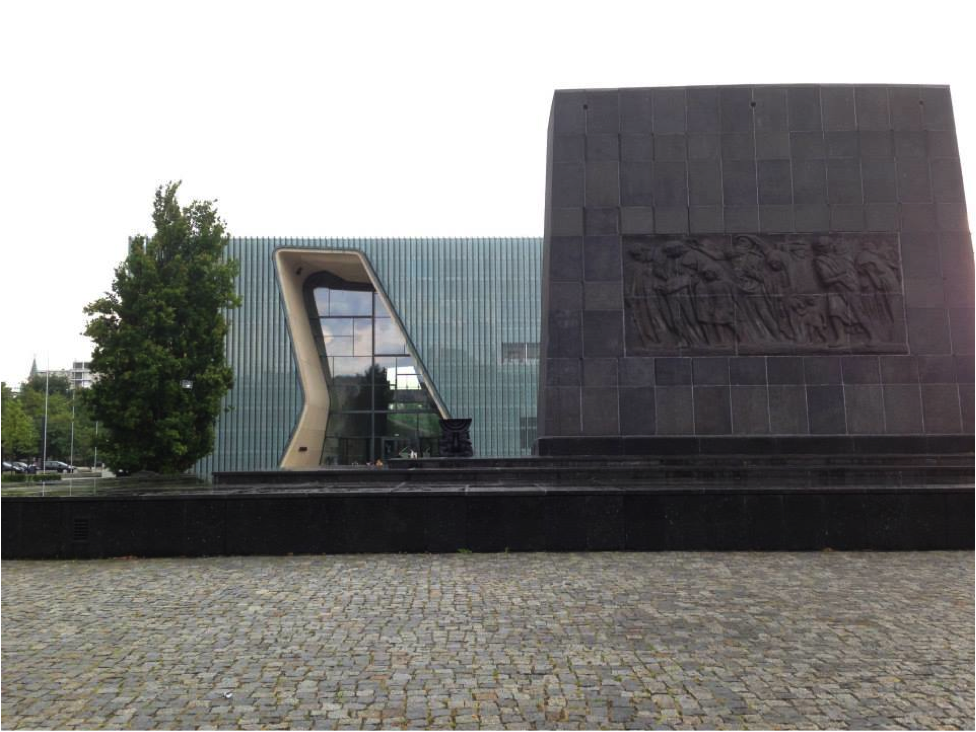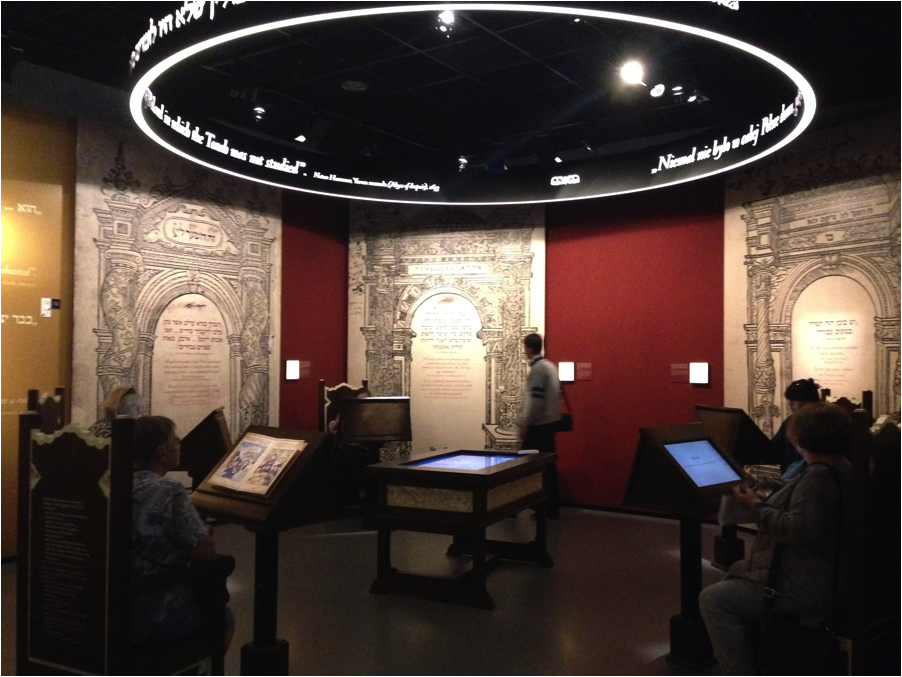
POLIN Museum of the History of Polish Jews and the Monument to the Ghetto Heroes in Warsaw, Poland.
The opening of POLIN Museum of the History of Polish Jews’ core exhibition on October 28, 2014 marked an important day in Polish-Jewish history. After years of controversies and compromises, the final product represents the dedicated efforts of an array of scholars from various fields. The Museum itself is located in the heart of Warsaw’s pre-war Jewish neighborhood, Muranów, the site of the former Warsaw Ghetto, and it faces directly the Monument to the Ghetto Heroes.
The idea to create such a museum first came to Grażyna Pawlak in 1993 after she attended the dedication of the United States Holocaust Memorial Museum in Washington, D.C. At the time, Pawlak was the Director of Development for the Association of the Jewish Historical Institute of Poland. In 2005, the Museum was formally founded by the Association of the Jewish Historical Institute of Poland, the City of Warsaw, and the Polish Ministry of Culture and National Heritage. POLIN stands as the first public-private partnership for a cultural enterprise in Poland.

(Left) Anti-German poster in Warsaw representing the lasting tensions between Poles and Germans after the Second World War; (Right) The Palace of Culture and Science.
POLIN, however, is not intended to be a Holocaust museum, and visitors who expect the Holocaust to be its main focus, may well be surprised. While Poland was at the center of the Holocaust, and while 90% of the 3.3 million Jews living in Poland were murdered between 1939 and 1945, the museum tells the full one thousand year history of Jews in Poland, when Poland was home to the largest Jewish community in the world.
The core exhibition makes the case that Polish history and Jewish history have been inextricably bound, and that one can’t be understood without the other. The curators wanted to avoid a master narrative in the core exhibit, and they did not want to treat the history of Polish Jews as a “footnote” to Polish history. Just as importantly, they wanted to demonstrate that the history of Polish Jews was not confined to the experience of the Holocaust.

(Left) Warsaw’s Castle Square, Plac Zamkow w Warszawie; (Right) Jewish cemetery in Warsaw.
The core exhibit was shaped by Barbara Kirshenblatt-Gimblett, a professor of performance studies at New York University, who was appointed to as the exhibition director in 2006. She drew upon her theater background to create twelve over-arching principles that served as a guide for the core exhibit’s design. Essentially, she wanted to create an open, interactive experience for the museum visitors.
This experience begins when visitors first enter the building. As they pass through the main doors, they encounter a large glass window. Unlike the U.S. Holocaust Museum in Washington, D.C. and the Jewish Museum in Berlin, both architecturally dark and a bit forbidding, POLIN offers a space of light, openness, and reflection. In addition to the exhibits, POLIN serves as a place of conversation between scholars and the public, especially about the present-day revival of Jewish life in Poland, and it functions as a cultural center that hosts lectures, films, concerts, and theater performances.

(Left) Marking the location of the Warsaw Ghetto Wall in the Muranów neighborhood; (Right) A portion of the large glass window in POLIN.
The core exhibition itself is divided into eight chronological galleries. The 1,000-year history begins in the forest, a space of historical imagination, and tells the legend of how Jews got to Poland. This is where Poland got its name, which is Polin in Hebrew. It loosely translates to “here you should dwell,” and thus this area was seen to be a safe place for Jews to live. Here in this gallery, museum visitors pass through several screens that have trees projected onto them.

(Top): Gallery #1: Forest – Legend of how the Jews got to Poland; (Bottom Left) Gallery #2: First Encounters (960 – 1500) – Focuses on the role of Jews as traveling merchants in the local economy; (Bottom Right) Gallery #3: Paradisus Iudaeorum (1569 – 1648) -- Emergence of the Polish-Lithuanian Commonwealth, commonly referred to as the “Golden Age” in the history of Polish Jews. This gallery features a multimedia topographical scale model of Krakow and the neighboring town of Kazimierz.
As visitors pass through the mystical woods, they are transported back in time and begin their journey. The core exhibition is divided into the following galleries: First Encounters (960 – 1500), Paradisus Iudaeorum [Jewish Paradise] (1569 – 1648), The Jewish Town (1648 – 1772), Encounters with Modernity (1772 – 1914), On the Jewish Street (1918 – 1939), Holocaust (1939 – 1945), and Postwar Years (1944 – present). The core exhibit relies heavily on multi-media, reconstructed objects, and quotes to tell the millennium-long history of Polish Jews. Each gallery employs different visual methods to enhance the historical narrative.

(Top Left): Gallery #4: The Jewish Town (1648 - 1722) -- reconstructed wooden synagogue; (Top Right): Colorful ceiling decorated with Hebrew, animals, and zodiac symbols; (Bottom): Gallery #5: Encounters with Modernity (1722 - 1914) -- With the partition of Poland in 1722, this gallery explores how each power - Russia, Prussia, and Austria - dealt with the "Jewish Question."
The centerpiece of the core exhibition is the reconstructed wooden synagogue in “The Jewish Town” gallery. All wooden synagogues from the 17th and 18th centuries have been destroyed so POLIN’s curators decided to recreate the well-documented synagogue in Gwoździec (now modern day Ukraine). It was originally built c. 1650, then renovated in the 1720s, and was destroyed during the First World War.

(Top): Gallery #6: On the Jewish Street (1918 – 1939) – The museumgoer enters a multimedia street inspired by the Yiddish expression, yidishe gas, which represents Jewish life during the interwar years. Here the visitor hears the loud, busy noises of everyday life; (Bottom Left) Gallery #7: The Holocaust (1939 – 1945) – Museumgoers climb steps in this gallery that are reminiscent of the bridge over the Warsaw Ghetto; (Bottom Right) Gallery #8: Postwar Years (1944 – Present) – Multimedia display that represents the ruins and remains found in post-World War II Warsaw.
In order to recreate this particular synagogue, POLIN collaborated with Handshouse Studio, an educational nonprofit organization, and enlisted hundreds of volunteers. They used traditional tools, materials, and techniques to reconstruct the wooden synagogue. The painted ceiling and bimah are detailed, colorful, and vibrant. The final product looks absolutely beautiful and is extremely popular among museum-goers.
 |
| Visitors have the opportunity to sit down and browse through a virtual library that contains some masterpieces of Hebrew and Yiddish literature. |
The core exhibit relies heavily on multi-media installations because there are simply so few original objects have survived to be put on display. Some scholars and museum professionals have criticized POLIN for its use of so many reconstructed objects and replicas. Likewise, some visitors find the multimedia displays and sounds to be too loud and overwhelming.
In this sense, POLIN turns out to be a Holocaust museum after all, if only indirectly by dealing with questions of authenticity and absence. POLIN demonstrates to visitors that Jewish life in Poland flourished for centuries and that it did not completely die after 1945. The Museum is part of the larger, historical narrative of Polish-Jewish relations and the recent revival and renewed interest of Jewish life in Poland today. But because it can only fill this historical void with recreations and multi-media displays, it is also a reminder that the Holocaust robbed all Poles, Jews and others, of their history.
